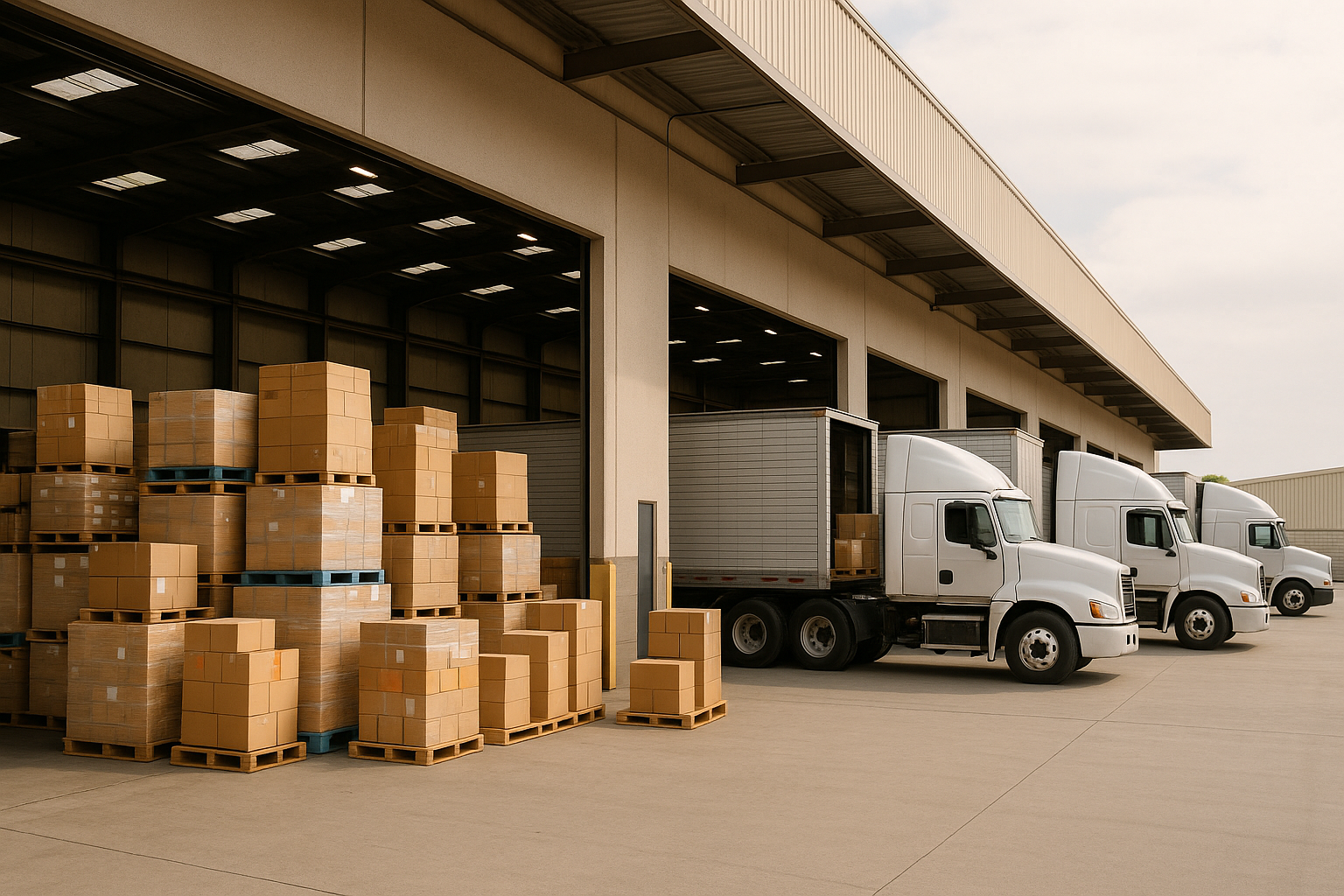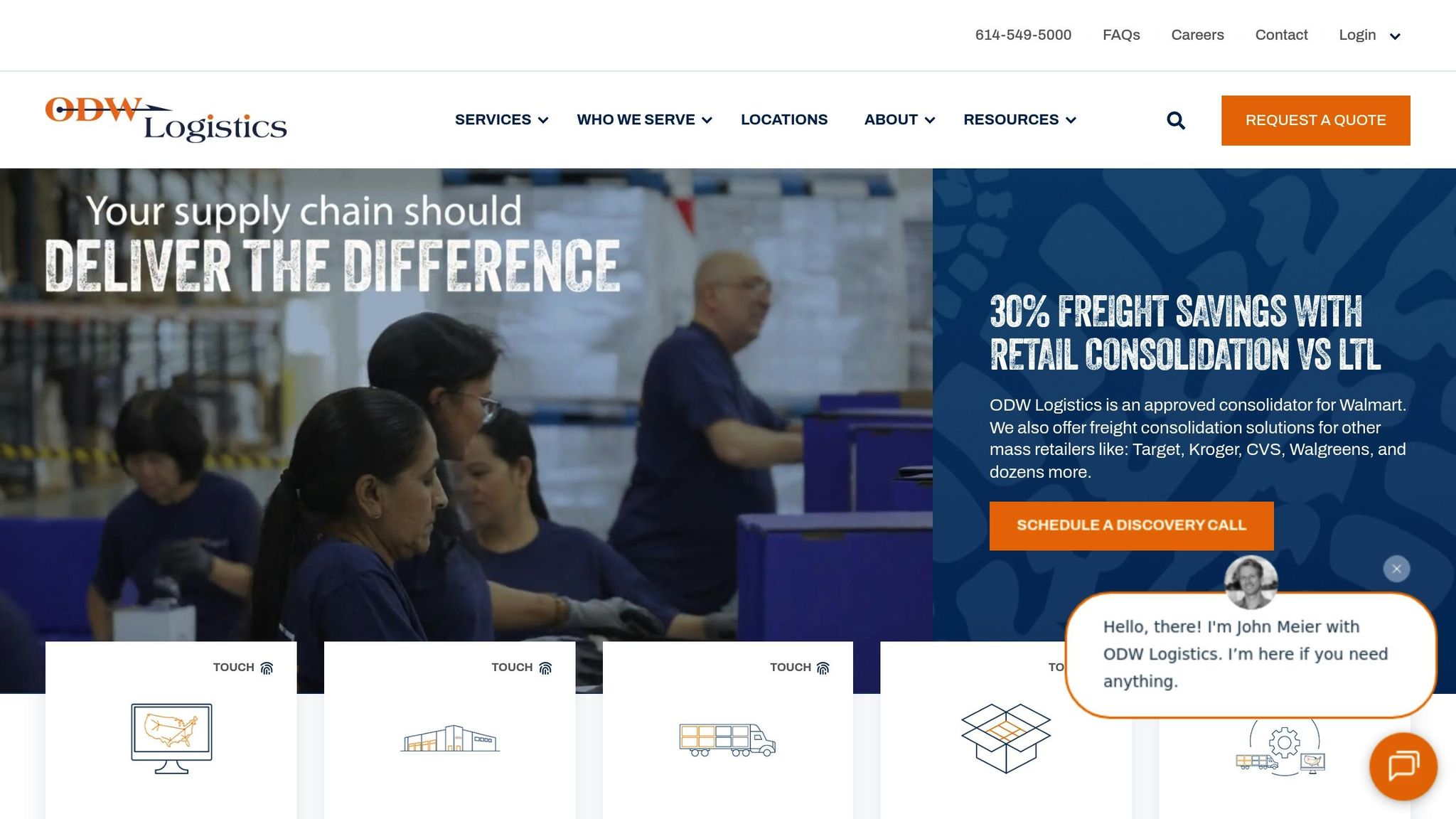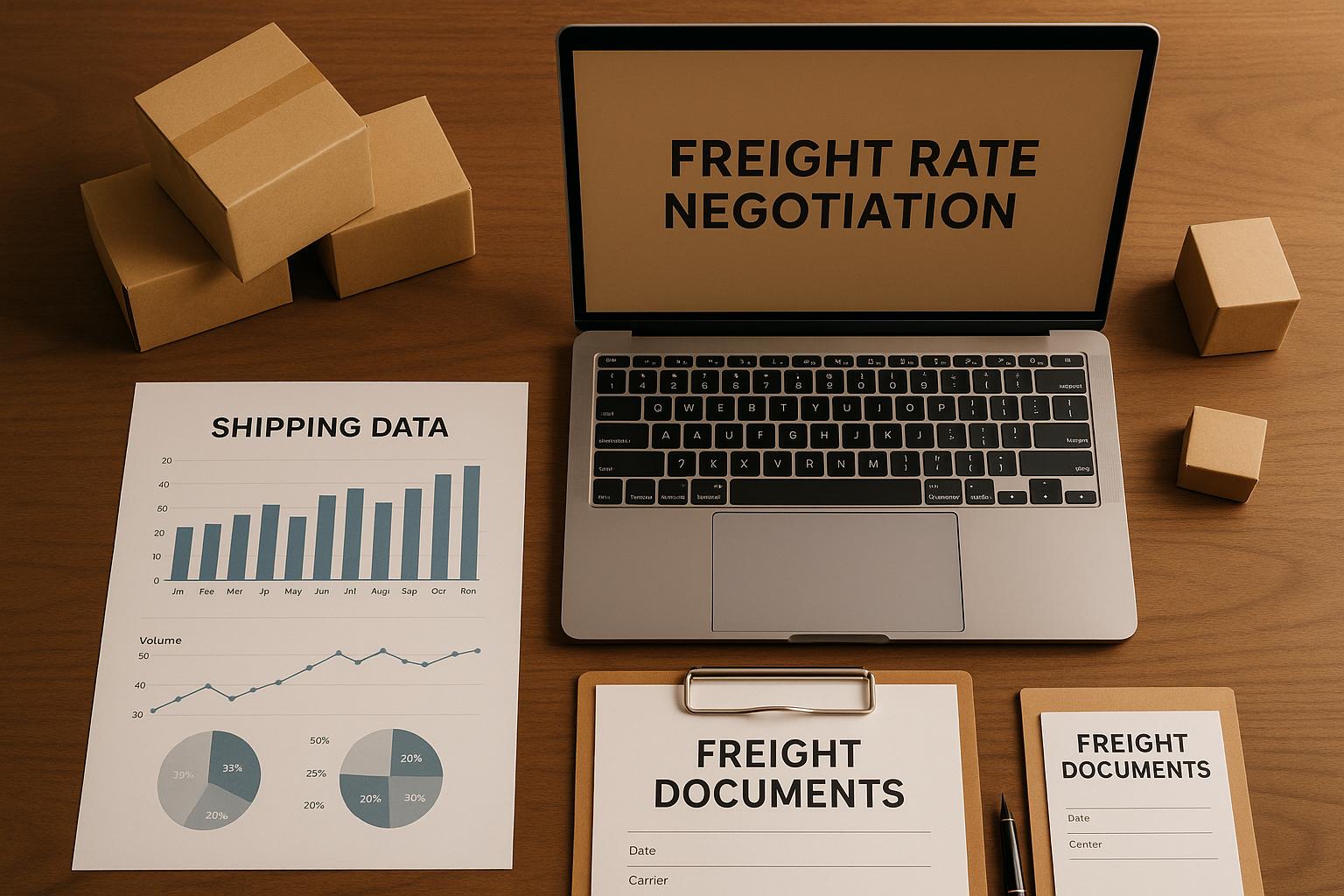Freight Consolidation vs Pool Distribution: Key Differences

When it comes to shipping strategies, freight consolidation and pool distribution are two effective methods for e-commerce businesses. Here's a quick breakdown:
- Freight Consolidation: Combines smaller shipments into a full truckload (FTL) to reduce costs. Ideal for predictable, non-urgent deliveries with nationwide reach.
- Pool Distribution: Positions inventory at regional hubs before orders are placed, enabling faster local deliveries. Best for high-demand, densely populated areas.
Key Considerations:
- Cost vs. Speed: Freight consolidation saves money but is slower. Pool distribution is faster but requires careful inventory planning.
- Shipment Volume: Consolidation works for larger, spread-out shipments; pool distribution thrives on steady regional demand.
- Customer Base: Nationwide customers? Go with consolidation. Regional demand? Pool distribution might be better.
Quick Comparison:
-
Purpose
- Freight Consolidation: Cost savings via bulk shipping
- Pool Distribution: Faster delivery through local hubs
-
Delivery Speed
- Freight Consolidation: Slower
- Pool Distribution: Faster
-
Ideal Use
- Freight Consolidation: Nationwide, predictable shipments
- Pool Distribution: Regional, high-density areas
-
Cost Focus
- Freight Consolidation: Lower per-pound shipping costs
- Pool Distribution: Reduced last-mile delivery expenses
Your choice depends on your business goals: prioritize cost efficiency with freight consolidation or speed with pool distribution.
ODW Logistics | Transportation Management | 3PL

What Are Freight Consolidation and Pool Distribution
These two shipping methods offer distinct approaches to managing shipments and inventory, each with its own processes and benefits. Here's a closer look at how they work.
Freight Consolidation Explained
Freight consolidation combines smaller shipments into a single, full truckload heading to the same region. Essentially, it turns less-than-truckload (LTL) shipments into full truckload (FTL) shipments. For instance, if you have three orders bound for Texas, they can be grouped together in one truck. Once the truck reaches Texas, the shipments are separated and delivered to their final destinations using local carriers.
The main advantage of freight consolidation is cost savings. Shipping companies charge less per pound for full truckloads, so consolidating shipments helps you benefit from bulk pricing. Plus, it reduces the number of trucks on the road, which can also lessen your environmental impact.
That said, this method works best when your shipping volumes are predictable and delivery speed isn't your top priority. Since it takes time to gather enough shipments to fill a truck, transit times are usually longer compared to direct shipping options.
Pool Distribution Explained
Pool distribution takes a different approach by moving inventory closer to your customers before orders are even placed. Instead of shipping individual orders directly from your main warehouse, you send bulk shipments to regional hubs, also known as "pool points", located near areas with high customer demand.
Here’s how it works: You ship a large quantity of products to a regional hub, where they are temporarily stored. When customers place orders, the items are picked, packed, and delivered from this nearby location. This process significantly reduces last-mile delivery times.
Pool distribution is particularly effective in densely populated metropolitan areas. For example, if many of your customers are in Chicago, you could set up a pool point in a nearby suburb. Instead of shipping each order from a warehouse in California, you send bulk inventory to the Chicago hub and fulfill orders locally from there.
However, this method requires careful planning and inventory management. You need to anticipate customer demand in different regions and stock the pool points accordingly. The payoff? Faster delivery times and potentially lower costs for the final delivery leg.
The key distinction between these two methods lies in timing. Freight consolidation happens after customers place their orders, while pool distribution involves pre-stocking inventory in advance. These differences in operation directly affect costs, risks, and overall efficiency. Up next, we’ll delve deeper into how each method handles shipments and their unique operational challenges.
How Each Method Works
Freight consolidation and pool distribution operate differently, each catering to specific business needs. These methods vary in how shipments are handled, the volume they require, and the speed of delivery - each offering its own set of benefits and challenges.
Shipment Handling Process
Freight consolidation brings orders together at a central hub, where they are sorted by destination region and combined into full truckloads. Once the truck reaches its destination, the shipments are separated for their final deliveries. While this process involves multiple handling stages, it provides opportunities for quality checks and shipment verification along the way.
In contrast, pool distribution uses inventory already stored at regional pool points. When orders are received, staff at these locations pick, pack, and ship the products directly to customers in the area. With fewer handling steps, this method reduces the risk of damage and speeds up the fulfillment process. These differences in operation lay the groundwork for variations in volume requirements and delivery speeds.
Volume and Density Needs
Freight consolidation thrives on high shipment volumes heading to concentrated areas. It’s most efficient when orders are destined for regions with a significant number of deliveries, rather than scattered locations.
Pool distribution, on the other hand, benefits from high customer density in specific geographic zones. By forecasting demand, businesses can stock just the right amount of inventory at each pool point, avoiding overstocking while keeping capital free for other needs. These volume strategies directly influence how quickly shipments reach customers.
Speed and Timing Differences
Freight consolidation often comes with longer transit times due to the need to wait for enough orders to fill a truck. It’s a cost-effective option for non-urgent shipments where speed isn’t the top priority.
Pool distribution, however, positions inventory closer to customers, enabling much faster fulfillment. In some cases, this can mean delivery within a day - or even the same day - in areas with high demand. But to make this work, businesses must carefully plan inventory levels to ensure pool points are stocked ahead of peak periods.
Ultimately, the choice between these methods comes down to shipment volume and customer density. Freight consolidation focuses on cost savings by waiting for full truckloads, while pool distribution prioritizes speed by anticipating demand. The decision affects not just timing but also overall costs and service quality, making it crucial to align logistics strategies with business goals.
Costs and Risks
When it comes to logistics, weighing the costs and potential risks of different distribution methods is crucial for making smart business decisions. Both freight consolidation and pool distribution offer opportunities to save money, but they come with challenges that could impact your overall operations.
What Influences Costs
Freight consolidation focuses on combining smaller shipments into full truckloads. This reduces the number of handling cycles, lowers fuel expenses, and minimizes the risk of product damage. Fewer trucks on the road translate to savings on fuel and handling, and this efficiency might even cut down on the need for significant investments in storage and transportation infrastructure.
Pool distribution takes a different approach by using regional hubs to position inventory closer to customers. This setup can streamline last-mile delivery by eliminating unnecessary transportation legs. Additionally, stocking smaller amounts of inventory across multiple locations could help lower the costs associated with holding excess stock. However, detailed cost breakdowns for pool distribution are less commonly documented in available sources.
While these methods can reduce expenses, it’s important to consider the operational risks that might offset these savings.
Challenges and Limitations
Despite the potential for savings, both freight consolidation and pool distribution come with operational hurdles that could impact efficiency and costs.
Freight consolidation requires careful coordination among shippers, carriers, and freight brokers. Miscommunication or poor planning can lead to delays and the need for rescheduling. Carriers might also impose extra fees for additional stops or handling tasks tied to consolidated loads, which could chip away at the expected savings. Plus, external factors like bad weather can disrupt shipments, increasing the likelihood of delays or damage. This method may also struggle to meet the demands of reverse logistics or situations requiring extremely short lead times.
Pool distribution has its own set of challenges. For this model to work well, there needs to be a steady flow of shipments heading to a specific region. Without enough volume, the cost benefits may disappear, making traditional less-than-truckload (LTL) shipping a better option. Additionally, not all products are suitable for pooling - items requiring special handling might not align with this method. Success also hinges on working with a logistics provider that has a strong regional network and ensuring smooth coordination among all involved parties, which can be tricky to manage.
sbb-itb-eafa320
Side-by-Side Comparison
A direct comparison highlights the differences between freight consolidation and pool distribution in terms of purpose, shipment handling, and cost structure.
Feature Comparison Table
-
Primary Purpose
- Freight Consolidation: Combines shipments to secure bulk shipping rates
- Pool Distribution: Positions inventory at regional hubs for quicker local delivery
-
Ideal Shipment Size
- Freight Consolidation: Small to medium shipments (under 10,000 lbs)
- Pool Distribution: Shipments of various sizes heading to the same region
-
Aggregation Point
- Freight Consolidation: Origin consolidation center
- Pool Distribution: Regional distribution hubs
-
Handling Touches
- Freight Consolidation: Minimal handling stages
- Pool Distribution: 3-4 stages (pickup, hub sorting, local distribution, delivery)
-
Delivery Speed
- Freight Consolidation: Slower due to time spent consolidating shipments
- Pool Distribution: Faster for deliveries within regional areas
-
Geographic Focus
- Freight Consolidation: Best for long-haul shipments
- Pool Distribution: Tailored for regional market delivery
-
Volume Requirements
- Freight Consolidation: Needs consolidated shipments for specific regions
- Pool Distribution: Relies on steady demand in particular areas
-
Cost Structure
- Freight Consolidation: Lower transportation costs per pound
- Pool Distribution: Lower last-mile delivery costs
Pros and Cons Table
-
Freight Consolidation
-
Advantages:
• Lower transportation costs thanks to full truckload rates
• Fewer vehicles used, reducing fuel expenses
• Minimized product damage due to fewer handling stages
• Eco-friendly through optimized truck utilization -
Disadvantages:
• Longer transit times caused by consolidation delays
• Complex coordination between multiple parties
• Weather risks affecting consolidated loads
• Limited flexibility for urgent shipments
-
Advantages:
-
Pool Distribution
-
Advantages:
• Faster delivery improves customer satisfaction
• Lower inventory costs across multiple locations
• Quick response to regional demand changes -
Disadvantages:
• Requires consistent volume to specific regions
• Higher complexity managing multiple hubs
• Not ideal for shipments needing special handling
• Relies on provider network strength
-
Advantages:
The decision between these two methods largely depends on your priorities: cost efficiency or delivery speed. Freight consolidation is ideal for cutting costs on long-distance shipments when you can accommodate longer transit times. On the other hand, pool distribution is better suited for serving regional markets quickly, especially when demand is consistent in specific areas.
The network setup also plays a role. Freight consolidation typically works with a straightforward hub-and-spoke model, while pool distribution requires a more intricate multi-hub network with strong regional coverage. This distinction influences both the complexity of the setup and the ongoing operational requirements.
This breakdown offers a clear foundation for selecting the method that aligns best with your operational goals and logistics strategy.
Which Method to Choose
Deciding between freight consolidation and pool distribution comes down to understanding your shipment patterns, delivery needs, and operational goals. Each method has its strengths, and the right choice depends on your specific circumstances.
Main Decision Factors
Delivery density is a key consideration. If you frequently ship multiple orders to customers in a concentrated area - like a major city - pool distribution might be the better fit. This method works well in regions with a dense customer base. On the other hand, freight consolidation is ideal for shipments spread across broader areas, where combining loads can help cut costs.
Shipment frequency also matters. Pool distribution thrives on consistent, localized shipment volumes that justify the use of hub infrastructure. If your shipments are less frequent or follow varied routes, freight consolidation offers the flexibility you need.
Handling requirements are another factor to weigh. Products that need extra care benefit from freight consolidation, as it involves fewer handling stages. In contrast, standard items like clothing, books, or electronics are generally well-suited for pool distribution.
Speed priorities play a role too. If your customers expect quick regional deliveries, pool distribution can handle the last-mile service more efficiently. However, if they’re open to slightly longer transit times in exchange for cost savings, freight consolidation could be a better option.
Finally, cost sensitivity is crucial. Freight consolidation helps reduce per-pound shipping costs and adapts well to seasonal changes in volume. In dense markets, pool distribution can provide faster delivery, which might justify the higher cost for some businesses.
Simple Decision Guide
To make the best choice, analyze your shipping data. Look at destination clusters, shipment volumes, and delivery timelines. Use pool distribution for concentrated regional markets, and opt for freight consolidation when shipments are irregular or spread out across multiple routes.
If you’re running an e-commerce business and need more tailored advice, working with a logistics provider like JIT Transportation can help. They specialize in crafting solutions that address both freight consolidation and pool distribution, ensuring your shipping strategy aligns with your business needs.
How to Put It Into Practice
With the operational differences in mind, let’s look at how to effectively implement freight consolidation or pool distribution. Success here depends on careful planning, the right technology, and flawless execution. The goal? Build a system that supports your chosen method while remaining flexible enough to adapt as needs evolve.
Network Setup and Planning
Start by identifying the best locations for your operations. For freight consolidation, establish hubs along major transportation routes where shipments can be combined efficiently. For pool distribution, focus on high-density areas that allow for quicker last-mile delivery. These locations should be close to your main shipping origins and have easy access to highways and carrier networks.
Once your network is mapped out, analyze your shipping data. Look at historical trends, such as peak seasons and average shipment sizes, to determine staffing, warehouse space, and equipment needs. This kind of data-driven planning ensures you’re ready for both busy and slower periods.
Scheduling is another key piece of the puzzle. For consolidation hubs, set clear cut-off times for shipments to arrive and have contingency plans for periods of low volume. For pool distribution, align inbound and outbound schedules to minimize both storage time and handling costs.
Don’t forget about the physical setup of your locations. Consolidation hubs need enough dock space for multiple trailers, while pool points should have sorting and staging areas optimized for last-mile deliveries. Consider factors like local labor availability and proximity to major roads when choosing these sites.
With these foundational steps in place, you’ll be ready to integrate the technology that makes everything run smoothly.
Technology and Tracking
To manage freight consolidation and pool distribution effectively, real-time tracking is a must. Modern warehouse management systems (WMS) and transportation management systems (TMS) give you the tools to monitor shipments at every stage. By using barcode scanning at each touchpoint - from pickup to delivery - you can create a detailed audit trail to identify bottlenecks and improve performance.
Advanced tracking systems also ensure that individual orders remain identifiable, even when grouped into larger shipments. These systems can send automatic alerts for delays or volume issues, helping you stay ahead of potential problems.
Integration is another critical factor. Your tracking technology should work seamlessly with e-commerce platforms, ERP systems, and communication tools. This allows for real-time updates to customers and helps your team make informed decisions about routing and scheduling.
Over time, data analytics from these systems can help you refine your operations. Insights into delivery times, costs, and customer satisfaction make it easier to identify the most efficient routes, optimize pool points, and adjust your network as your business scales.
Once your technology is in place, consider adding extra services to further streamline your shipping process.
Adding Extra Services
Offering additional services can enhance efficiency and improve the customer experience. For example:
- Pick and pack services: Properly picking and packing orders before they enter your network reduces handling time and improves accuracy, especially for e-commerce businesses shipping multiple SKUs to the same area.
- Kitting and assembly: This is particularly useful for freight consolidation, as longer transit times allow for value-added activities like assembling products or creating promotional packages.
- White glove handling: For high-value or fragile items, this service ensures careful handling throughout the shipping process, from consolidation to final delivery.
- Returns management: Returns can be tricky, but setting up reverse logistics processes at your hubs or pool points can streamline this aspect without disrupting regular shipments.
Partnering with a logistics provider like JIT Transportation can make these strategies easier to implement. Their nationwide network, advanced technology, and expertise in freight consolidation and pool distribution allow you to optimize your logistics operations with confidence. From planning to execution, they provide the tools and support needed to simplify even the most complex shipping processes.
Conclusion
Deciding between freight consolidation and pool distribution depends on your unique logistics needs and priorities. Freight consolidation works best for long-haul shipments with steady, predictable volumes, offering a way to cut costs on these extended routes. On the other hand, pool distribution thrives in high-density markets where quick delivery is essential. It’s particularly well-suited for e-commerce businesses aiming to meet tight delivery windows and enhance customer satisfaction.
When weighing these options, it’s important to align your choice with your broader business goals. Are you prioritizing cost savings, or is delivery speed your main focus? Factors like shipment volumes, customer expectations, geographic coverage, and budget constraints should guide your decision.
Partnering with an experienced logistics provider can make this process smoother. JIT Transportation brings expertise in both freight consolidation and pool distribution, backed by a nationwide network and advanced technology to execute either strategy effectively. Their tailored 3PL offerings - such as pick & pack services and white glove handling - provide the flexibility to adapt your logistics approach as your business evolves.
While the logistics industry continues to evolve, the core principles of consolidation and pool distribution remain essential for creating an efficient supply chain. By analyzing your shipping patterns, costs, and long-term objectives, you can choose the method that best supports your operations and enhances customer satisfaction.
FAQs
Which is better for my e-commerce business: freight consolidation or pool distribution?
When deciding between freight consolidation and pool distribution, it all boils down to your shipping goals, destination patterns, and cost-saving priorities.
Freight consolidation is a smart choice when you’re looking to combine smaller shipments from multiple suppliers into a single, larger load. This approach is particularly useful for cutting costs on less-than-truckload (LTL) shipments by ensuring trucks are fully utilized.
On the flip side, pool distribution works better if your shipments are all heading to the same region. By grouping these deliveries into one vehicle, you can speed up transit times and simplify last-mile logistics.
To make the right choice, think about your shipment volume, the delivery areas, and whether your focus is on saving money or speeding up deliveries. Both strategies can improve your supply chain efficiency when matched to your business needs.
What are the key challenges of using pool distribution in logistics?
Pool distribution comes with its fair share of challenges, mostly stemming from the need for careful coordination between multiple players. This means juggling shipments from different sources, aligning delivery schedules, and keeping communication flowing smoothly among everyone involved.
On top of that, managing trailer pools adds another layer of complexity. It demands robust tracking and scheduling systems to keep things running efficiently and prevent delays. Without proper management, these hurdles can take a toll on the speed, cost, and reliability of your distribution network.
Is freight consolidation a good option for businesses with fluctuating shipment volumes?
Freight consolidation is a smart strategy for businesses dealing with fluctuating shipment volumes. By merging smaller shipments into larger, more efficient loads, it cuts down transportation costs and ensures better use of available space. Beyond cost savings, it also allows for more flexible scheduling and smoother inventory management, which can be a game-changer when shipping patterns are unpredictable.
For companies looking to simplify their supply chain, freight consolidation offers a dependable way to keep costs in check while maintaining the flexibility needed to handle inconsistent shipping demands.
Related posts
Related Articles

Machine Learning in Logistics: Route Optimization Explained

Ultimate Guide to Transportation Metrics for 3PL

